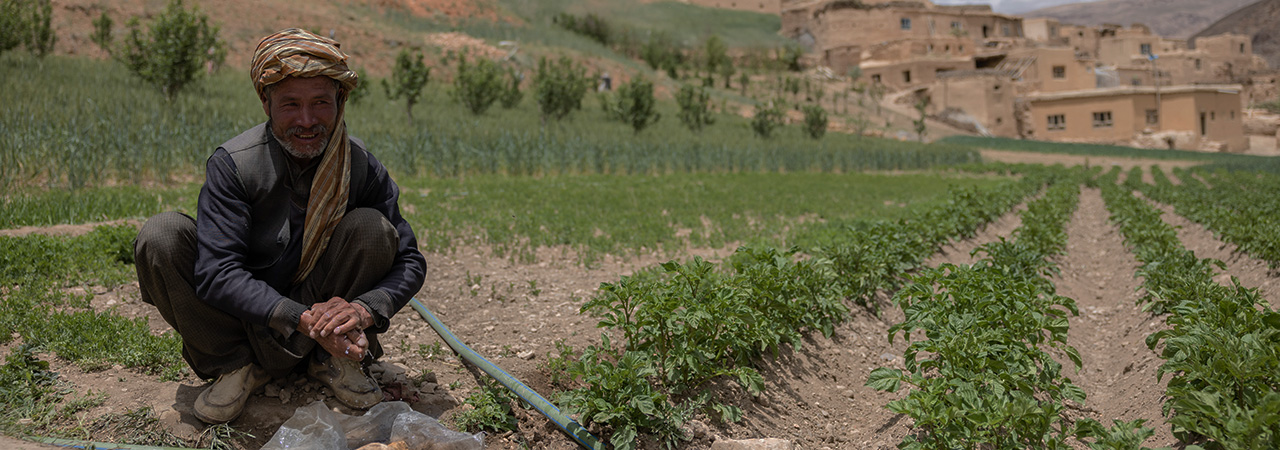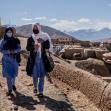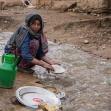

Media CenterA New CRS Report Shows Afghanistan Farmers are Taking Desperate Measures to Survive a Crippling Drought, Some Selling off Assets by as much as 90%
FOR IMMEDIATE RELEASE
CONTACT:
Megan Gilbert
Catholic Relief Services
[email protected]
(443) 825-3640
BALTIMORE, MARYLAND, Oct. 18, 2022 – Afghanistan farmers are resorting to extreme measures to cope with a severe drought and hunger crisis, a new Catholic Relief Services (CRS) report shows. Such measures include eating fewer meals, attempting to migrate, and selling off as much as 90% of their livestock to the point where recovering the herd becomes impossible.
“People are left with no good options to try to feed their families,” said Anne Bousquet, CRS country representative in Afghanistan. “They are doing what they can but rising food prices, no harvests, and high unemployment make it incredibly difficult.”
CRS’ report focused on 16 villages in Ghor province in the central highlands, where more than 20,000 people face “catastrophic” levels of food insecurity, which means people are facing starvation and death because of an extreme lack of food. The CRS assessment, conducted in June and July of this year, included visual observations of the land as well as 14 farmer focus groups. According to the assessment, farmers reported their wheat yields are 80% smaller than they would be during an average year. Wheat is a major staple of the diet in Afghanistan and when vulnerable families do not have bread to eat, they go hungry.
According to CRS’ survey, farmers are coping with the shortfall by selling off their livestock, which would be equivalent in the U.S. to a family liquidating their major financial assets. In interviews, farmers said that in 2010, a good year, they had on average 25 sheep and goats. The CRS assessment shows the size of herds has declined over the last two years, with farmers now having only three animals on average, a decrease of nearly 90%.
“This is a minuscule number,” said Michael Potts, CRS technical advisor for agriculture “If you have 20 animals it will take you three years to get back to 25. If you only have five animals left you will never recover. They permanently lose a major source of income.”
Climate change has made droughts far more common. Since 2008, Afghanistan has experienced a drought every two years, compared to once in a decade previously. Droughts in Afghanistan are caused by a number of factors, including the weather event La Nina, which is increasing in frequency due to climate change.
“Drought is also caused by natural resource degradation, which greatly impacts the “small water cycle,” which is the water captured locally by the earth and cycled back up to the atmosphere,” Potts said. “Now, water from rainfall and snowmelt quickly runs off degraded hillsides into rivers that flow out of Afghanistan, reducing its chance of returning as rainfall or snow.”
COVID-19 and the war in Ukraine have made coping with the drought even more difficult, according to the CRS assessment. “That triple whammy really hit people hard. The country is facing a huge shortfall. Potts said. “Everyone we spoke to has taken out a loan. Some people migrated to other provinces to look for work but they couldn’t get jobs or they couldn’t get jobs that paid enough to send money home so they came back.”
CRS is providing cash, high-quality seed and fodder for livestock. Water and sanitation projects provide access to clean water, particularly in areas where the village water supply is quickly dwindling. Still, with 97% of the population expected to be living below the poverty line by the end of the year, more investment is needed in longer term solutions. One such solution is the restoration of watersheds so they can better capture rainfall and snowmelt, thus increasing the local cycling of water that will enhance both crop and livestock production. In 2023, CRS aims to launch more projects in the sector of watershed restoration.
“The whole country is affected,” Potts said. “Working with 20 villages, 50 villages is just not going to cut it. The international community, including donors and NGOs, need a long-term nationwide solution.”
The full report can be found here.
###
Catholic Relief Services is the official international humanitarian agency of the Catholic community in the United States. The agency alleviates suffering and provides assistance to people in need in more than 100 countries, without regard to race, religion or nationality. CRS’ relief and development work is accomplished through programs of emergency response, HIV, health, agriculture, education, microfinance and peacebuilding. For more information, visit www.crs.org or www.crsespanol.org and follow Catholic Relief Services on social media in English at Facebook, Twitter, Instagram and YouTube; and in Spanish at: Facebook, Twitter and Instagram.
-----------------------------------------------------------------------------------------------------------------------------------------
Online Tools:
CRS Online Press Room: www.crs.org/press-room




